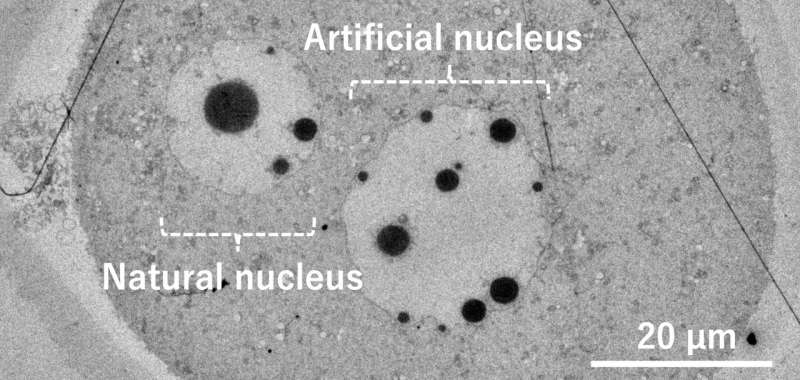Researchers from Kindai University have made a groundbreaking achievement by successfully constructing artificial cell nuclei using purified DNA injection into living mouse eggs. This revolutionary discovery sheds light on the mechanisms and conditions required for the formation and function of cell nuclei, paving the way for potential advancements in areas like the revival of extinct species and the creation of artificial life. The cell nucleus is a crucial organelle involved in numerous biological processes, and this research offers a significant step forward in understanding its intricate workings.

The secrets of nuclear formation are unlocked.
A research team at Kindai University aimed to clarify the mechanism of how a cell nucleus is organized and what are the minimal conditions required for its organization. Because making a liveable nucleus = seeing the nuclear construction process, very little has been known about the requirements of functional nuclei.
The researchers took a fresh approach: injecting a purified DNA solution into the egg of a living mouse, instead of using sperm. In this way, they were able to essentially perform a sort of fertilization and create a structure that closely resembled an actual cell nucleus. The researchers then used this knowledge to carefully control the behavior of the injected DNA and figured out how long and what concentration of a given combination of histone could trigger the formation of a nucleosome structure, a nuclear envelope, and even nuclear pore complexes necessary for the normal function in nuclear transport.
Observing the Formation of Synthetic Nuclei
The great finding of the study is that they were able to live-image nuclear pore complexes acquired by their injected DNA. Using this powerful new approach, they became the first in the world to film the formation of a synthetic nucleus endowed with nuclear transport activity.
The researchers discovered that when in and what form the DNA was added was crucial for the successful build-up of a nucleus. Through tight control over all of these variables, they were able to form an artificial nucleus that very closely resembled a natural one — including the essential mechanisms for transport. This discovery is fundamental to ongoing studies related to the development of an artificial cell nucleus, opening the door for a new horizon.
Realizing the potential of a fake life
This is potentially groundbreaking research. The ability the create a functional artificial nucleus has important implications for biotechnology and beyond.
One of the most thrilling future uses could be in bringing back species from extinction. Knowing what triggers the beginning of a cell’s nucleus, may enable us to recreate those nuclei from animals that had been extinct millions of years prior. Moreover, in collaboration with the construction of artificial cell nuclei,i.e., wholly artificial life forms, a new toolbox for synthetic biology might be done offering and emerging as new dimensions to the extremely paneled investigative capacities for livesbrakk during certain times.
Although these all sound like the stuff of science fiction, they nevertheless illustrate how far advances in our comprehension of life’s basic components have progressed. In unraveling cell nuclei, the power to change our world is even more imminent.
